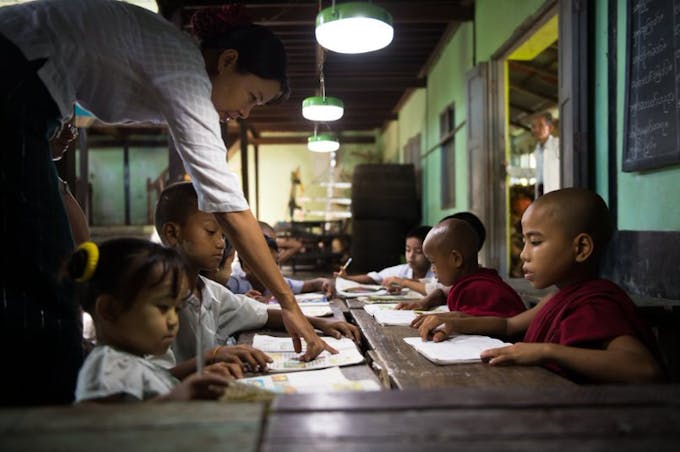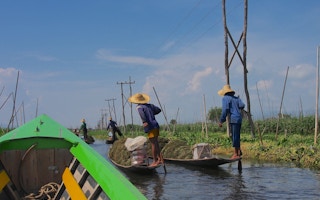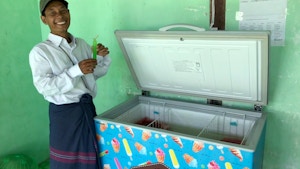Among the 10 countries that make up the Asean, Myanmar has the highest percentage of renewables in its energy mix - hydropower constitutes 65 per cent of generated electricity.
But this figure alone masks the country’s absymal rate of electrification, with chronic power shortages a regular occurence and more than 40 per cent of its total population still lacking access to the national grid. Sixty per cent of Myanmar’s rural populace live off gid, relying on polluting, expensive kerosene lamps and firewood to illuminate their homes.
Providing clean and sustainable electricity to off-grid areas is a challenge, to say the least. Assaad Razzouk, chief executive of clean energy projects developer Sindicatum Sustainable Resources comments: “Even India, a country that has seen great success in scaling up utility-scale solar, has struggled to scale up distributed and rooftop solar [in rural villages]. Fundamentally what’s required are clear government policies and credit support for the rural population.”
This has not stopped the previous government from announcing its goal to provide full access to electricity by 2030. Aung San Suu Kyi’s National League for Democracy (NLD) inherited these lofty ambitions when it swept into power later that same year, as well as a growing economy with low foreign direct investment and weak infrastructure.
Coal is one option to jumpstart Myanmar’s fledgling economy. But local experts caution against relying mainly on imported bituminous coal to fuel power plants, which would also set the country back on its emissions targets and climate action. And despite its abundant stores of natural gas, developing the infrastructure to tap and store it countrywide would be costly.
Yet the energy ministry anticipates coal making up 30 per cent of the energy mix by 2030 from 2 per cent of 2011 figures; a drop in natural gas; while hydro power is expected to fall from 70 per cent in 2011 to 57 per cent in a decade, according to a EuroCham report.
But a decrease in the overall share of the energy mix could still mean an increase in absolute terms as the country’s demand for electricity surges thanks to economic development. Hydropower, generally considered a renewable source of energy, has historically provided the lion’s share of total power generation capacity.
But the local population has grown wary of hydropower. The construction of the Hat Gyi dam on the Salween River, the heart of a bloody conflict between the Karen ethnic minority and Myanmar’s military, will displace up to 30,000 people and wipe out much of the river’s biodiversity. Furthermore, a number of large dams are built to export power neighbouring countries rather than local communities, including the now-mothballed Myitsone Dam that would have exported electricity to China.
Continued reliance on hydropower also leaves Myanmar vulnerable to power shortages and blackouts during the annual dry season when water levels dip like in May this year.
Still, there are 200 large dams for hydroelectric power in the country and plans are underway to build 45 more. “In the short term, hydro will clearly continue to thrive especially because it is currently picking up momentum – but this is clashing with the importance of fishing in Burmese culture and the impact of hydropower on people and the environment,” says Razzouk.
Myanmar has the capacity for over 4,000MW of wind power, but the sector remains nascent.
What option does Myanmar have left?
Solar power: the missing piece for rural Myanmar?
Solar power is an inevitability for Myanmar, says Razzouk. Cheaper than fossil fuels and quickly deployed, solar is also well suited in the Southeast Asian country with its high solar irradiation levels and flat physical landscape.
The Ministry of Electricity and Energy expects solar to account for 5 per cent of the national energy mix by 2030.
Intensification of solar is the missing piece to achieve rural electrification. Energy poverty analyst from the National University of Singapore’s Energy Studies Institute, Ira Martina Drupady, says that hydropower may deliver grid connections to urbanised areas but may fall short in addressing basic energy needs in rural areas.
Apart from electricity, she points to the need for off-grid technology to provide energy services like clean cooking stoves and heating. At the same time, energy providers must identify and take into account cultural sensitivities through feasibility studies
“Governments need to understand the specific energy services needs in these ‘last mile’ communities in order to solve their energy poverty issues. Reliance on large-scale technologies are often insufficient,” she said. This is especially the case in rural Myanmar, where only a third of its 64,000 villages receives electricity from the grid.
Investments and assistance are trickling in. In 2015, the World Bank launched a US$400 million initiative to finance grid extension and off-grid electrification to encourage the uptake of solar projects in rural areas.

A snapshot of Myanmar’s energy mix in 2011 and 2030, according to the Ministry of Electricity and Energy. Source: Energy Guide 2018, EuroCham Myanmar
Multinationals are stepping up. Japanese electronics company Panasonic donated 14,924 solar lamps to villagers in Myanmar, and runs programmes in local schools on energy conservation. The latest thrust to its corporate social responsibility programme includes installing off-grid solar generating equipment to help power small businesses and eliminate the need for polluting power sources such as kerosene lamps or firewood.

Solar lamps from Panasonic light up a school in rural Myanmar. Image: Panasonic
Pointing to the issue of regulatory frameworks, he adds: “Myanmar’s energy authorities need to accept foreign investment and increase awareness on sustainable energy”. Panasonic’s chief representative in Myanmar, Hirotaka Miura, acknowledges that while these projects are a good start, there is still a lack of awareness on sustainable energy among investors, project developers and energy companies in Myanmar.
Moving forward
If Myanmar is serious about sustainably electrifying its entire population, it must embrace fundamental changes to its energy, say experts.
Sindicatum’s Razzouk says the government must “[make] a concerted effort to tackle corruption, upgrade the currently weak rule of law, as well as upgrade the somewhat outdated regulatory framework for business,” in order to attract foreign investment for electrification.
Clearer government policies, clarity on credit risk for investors, and a smooth process for land and permit acquisitions would go a long way on this front, he elaborates.
Drupady also highlights the crucial role of non-state actors like civil society organisations to help deliver basic energy services in the absence of meaningful public and private sector participation.












